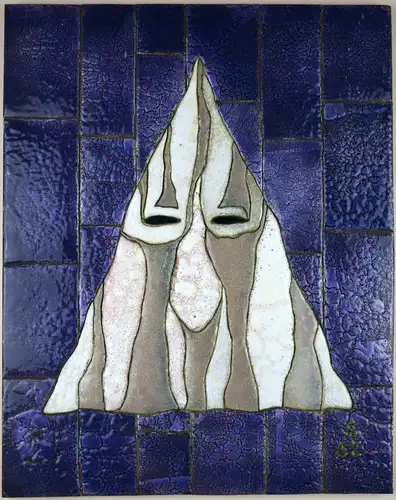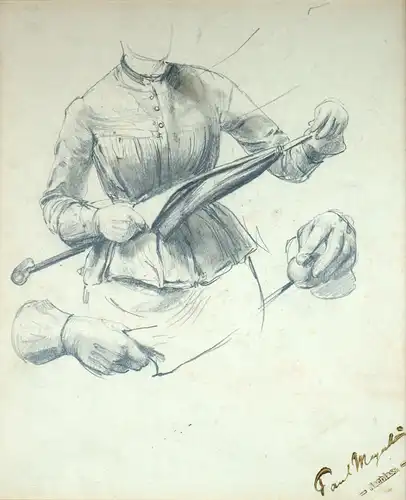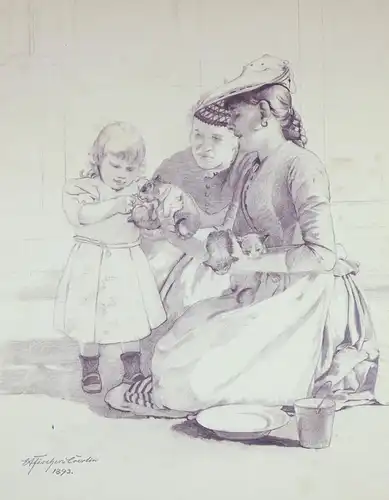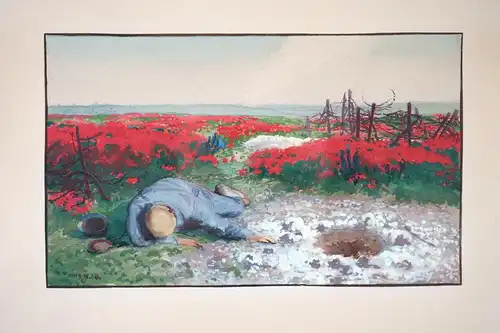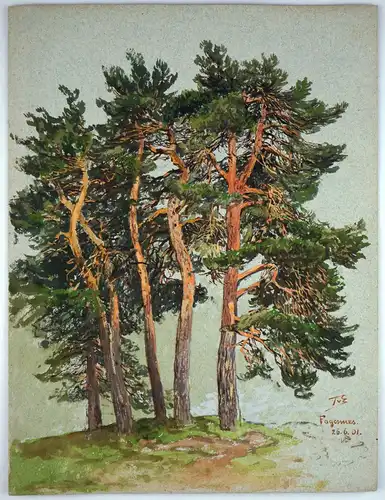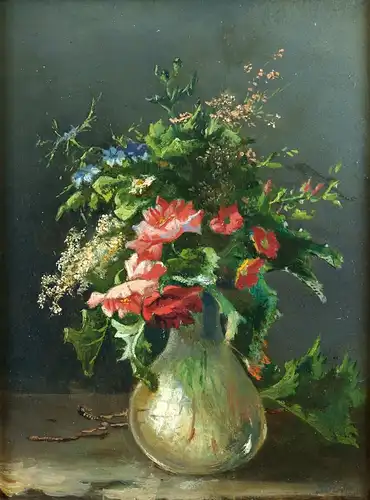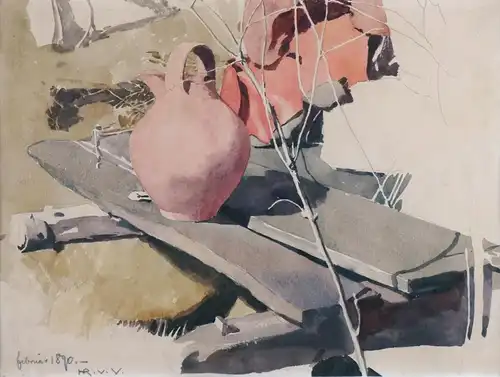Beschreibung
Jean-Baptiste Robie (1821 Brüsel - 1910 ebd.). Stillleben mit Wiesenblumen. Öl auf Holz, 24,5 x 18,5 cm (Innenmaß), 37 x 31 cm (Rahmen), rechts unten signiert und schwer leserlich datiert „J. Robie 19[…]“.
zum Werk
Das kleinformatige Kabinettbild stellt einen Blumenstrauß dar und reiht sich damit in das Genre des Stilllebens ein. Anstatt jedoch mit der Opulenz der oftmals üppigen in Feinmalerei ausgeführten Blumenbuketts zu wetteifern – was der Künstler, wie er es in anderen Werken veranschaulicht, durchaus vermochte –, präsentiert Jean-Baptiste Robie einen Strauß mit Gräsern und Blättern, wie er soeben beim Spaziergang auf einer Blumenwiese gepflückt worden sein könnte. Um diese Herkunft unmittelbar aus der Natur vor dem Haus zu unterstreichen, ist ein großes Blatt hinter die Vase gelegt, dessen teilweise bereits abgebrochenen Zweige auf der anderen Seite der Vase hervorschauen.
Durch die zahlreichen Blätter und die reduzierte Farbigkeit wirkt das Grün wie ein Binnenfond innerhalb des Straußes, der sich mit dem ebenfalls grüntonalen Hintergrund zusammenschließt. Vor dem Grün heben sich insbesondere die rosafarbenen Blüten ab, die eine Choreographie vollführen: Während die unteren Blüten herabhängen, richten sie sich nach oben hin zusehends auf. Dies veranschaulicht die Lebenskraft der Pflanzen. Nun wird deutlich, dass Robie das Sujet des Blumenstilllebens neu fasst: Es ist ihm nicht mehr daran gelegen, die prachtvolle Schönheit der Blumen herauszustellen, sondern ihre Vitalität aufzuzeigen und damit die innere Lebenskraft der Natur zu veranschaulichen, in der ihre Schönheit gründet. Diese Vitalität belebt den ganzen Strauß: Die Blätter sind vor innerer Spannkraft in sich gewunden und scheinen sich – wie die Blüten – dem Licht entgegenzustrecken.
Das kontrastreiche Spiel des Lichtes versetzt den Strauß in ein geheimnisvolles Hell-Dunkel und beruht auf Freilicht-Studien in der Natur. Dabei wird das Licht in impressionistischer Manier in Farbe übersetzt, was sich insbesondere bei der Gestaltung der Glasvase zeigt: Das Glas wird zur Farbfläche, die dennoch die Spiegelung des Fensters einfängt und die Stiele der Blumen und Blätter durchscheinen lässt.
zum Künstler
Jean-Baptiste Robie wurde in Brüssel als Sohn einen Schmiedes geboren. Zunächst hatte sich autodidaktisch gebildet bis er sich auf Anraten seines Künstlerfreundes Théodore Fourmois in die Königliche Akademie der Schönen Künste einschrieb und dort sein Kunststudium abschloss. Von 1843 bis 1875 stellte Robie im Brüsseler Salon aus, war aber auch im Pariser Salon vertreten. Eine weiter Bekanntheit erreichte er durch die Beschreibungen seine Reisen, die ihn bis nach Indien führten.
ENGLISH VERSION
Jean-Baptiste Robie (1821 Brussels - 1910 ibid.). Still life with meadow flowers. Oil on wood, 24.5 x 18.5 cm (inside measurement), 37 x 31 cm (frame), signed and dated (difficult to read) 'J. Robie 19[...]' at lower right.
About the artwork
This small-format cabinet painting depicts a bouquet of flowers and thus belongs to the still life genre. However, rather than compete with the opulence of the often sumptuous bouquets in fine painting - which the artist was quite capable of doing, as he illustrated in other works - Jean-Baptiste Robie presents a bouquet of grasses and leaves as it might have been picked during a walk in a flower meadow. In order to emphasise the fact that it is taken directly from nature in front of the house, a large leaf is placed behind the vase, its branches, some of which are already broken, protruding from the other side of the vase.
Because of the large number of leaves and the reduced use of colour, the green within the bouquet seems to be an internal background that merges with the green background. The pink flowers in particular stand out against the green, creating a choreography: As the lower flowers droop, they visibly straighten up towards the top. This illustrates the vitality of the plants. It is now clear that Robie is rethinking the subject of the floral still life: he is no longer interested in highlighting the magnificent beauty of the flowers, but in showing their vitality and thus illustrating the inner life force of nature in which their beauty is based. This vitality enlivens the whole bouquet: the leaves are twisted with inner strength and, like the blossoms, seem to stretch out towards the light.
The contrasting play of light bathes the bouquet in a mysterious chiaroscuro, inspired by studies of nature in the open air. Here, light is translated into colour in an impressionist manner, which is particularly evident in the design of the glass vase: The glass becomes a coloured surface that nevertheless captures the reflection of the window, allowing the stems of the flowers and leaves to shine through.
About the artist
Jean-Baptiste Robie was born in Brussels, the son of a blacksmith. He was initially self-taught until, on the advice of his artist friend Théodore Fourmois, he enrolled at the Royal Academy of Fine Arts and completed his art studies there. From 1843 to 1875, Robie exhibited at the Brussels Salon, as well as the Paris Salon. He achieved further fame through his descriptions of his travels, which took him as far as India.
